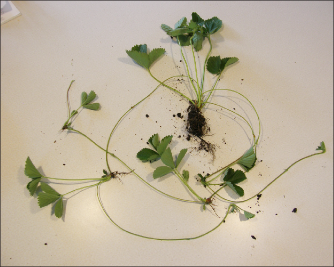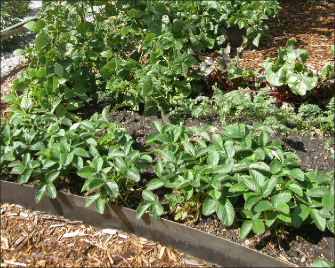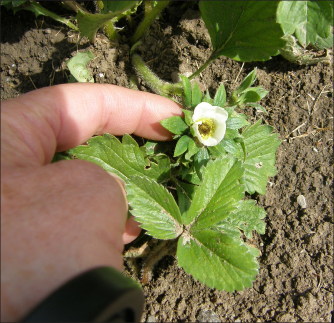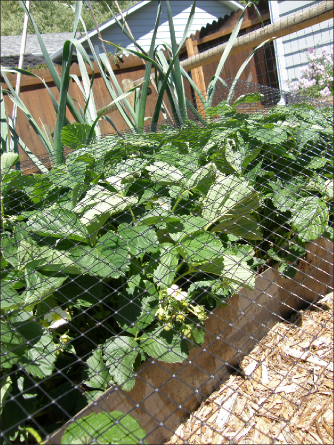
Strawberries in the Home Garden
This publication gives instructions for raising strawberries in Montana. It provides information about site selection and preparation, fertilizing, planting and training, winter protection, irrigation and pest control and includes a list of appropriate cultivars.
Last Updated: 11/19by Cheryl Moore-Gough, MSU Extension Horticulture Specialist and Dara Palmer, Montana Master Gardener Coordinator
STRAWBERRIES ARE A POPULAR SMALL FRUIT IN
the home garden. Gardeners may easily produce up to two pounds of berries per square foot of garden space every summer. Here’s how.
Bearing Types
Montana home gardeners can select from three bearing types of strawberries, June bearing, everbearing, and day neutral, each with a distinct fruiting schedule.
- June bearing – These produce one crop per year in early to mid-summer.
- Everbearing – These produce two crops in one season: The first in late June and July and the second in late August and September. In shortest- season locations, the everbearing cultivars may not be appropriate.
- Day neutral – Day neutral cultivars flower and fruit all summer long. In the far north they can grow as annuals when planted early and with some frost protection. That eliminates the problem of winter killing. In Montana, the fruiting season can be easily extended well into the fall with a row covering or cold frame. These cultivars may also be grown as fruiting house plants in a sunny location during the winter. They can fruit on unrooted runners and make attractive hanging plants.
Site Selection
The best berries are produced on fertile soils with good water-holding capacity, and in full sun; 10 hours per day is ideal. Don’t plant strawberries in low-lying frost pockets, since the plants are low to the ground and bloom very early, making them especially subject to frost damage. Be sure the location has good air circulation to help prevent disease.
Fertile sandy loams, silt loams or well-drained clay loams are the best soil types. Strawberries do best in slightly acid soils (pH 6.5), but can be grown in slightly alkaline soils as well. In soils with a pH above 8, strawberry plants develop lime-induced chlorosis, or yellowing between the veins of the youngest leaves, because of their inability to extract iron from the soil under these conditions. Before planting, arrange for a soil test to receive recommendations on fertility. See the MSU Extension MontGuide, Home Garden Soil Testing & Fertilizer Guidelines (MT200705AG) for more information.
Preparing the Bed
Work rotted manure or compost into soil to improve its structure and water-holding capacity. Form soil beds 36 inches wide and three to four inches above grade to assure good soil drainage.

FIGURE 1. An upended and modified shipping pallet may be used as a planter to save space.

FIGURE 2. The first step in heeling in plantlets that arrive too early to plant is to soak them in water.

FIGURE 3. The second step is to separate plantet roots.
There are several planting options for very limited space. Special “strawberry pots” have small openings in their sides where plants are set. Wooden whiskey barrels may also be used by boring two-inch holes in their sides. Be sure to bore a hole or two in the bottom of the barrel for drainage. Planting in an upended and modified wooden shipping pallet is another option (Figure 1, page 1). Another way to save space is to plant into a pyramid made up of several metal rings, wooden terraces or pots, decreasing in size from ground level to the highest tier. Make each level 12 inches smaller than the one beneath it so that, by centering it on the lower one, you allow six inches of level soil for plant growth in each tier.
Fertilizer
Nitrogen and potassium are nutrients needed in the greatest quantities for good strawberry production. Too little nitrogen results in small, light green leaves and stunted plants. Too little potassium, which is seldom a problem in our soils, causes formation of tan to brown spots at edges of leaves and between the leaf veins.
When planting a new bed, work a complete fertilizer such as 16-16-16 into the top six inches of soil at the rate of about 1.5 pounds per 100 square feet of garden area. For a bed 36 inches wide, apply this amount to 33 linear feet of row. This will encourage strong plant growth the first season. In the second and subsequent years for June bearers, don’t fertilize until after harvest. Then apply fertilizer at the rate suggested above but be sure the foliage is dry at application and sweep fertilizer granules off the leaves to reduce the chances of burning the foliage.
Planting and Training
Many local nurseries stock a selection of strawberry plants in spring, but a greater variety is offered online. If new plants arrive before conditions are right for spring planting, hold them in the refrigerator wrapped in moist packing material to reduce drying. If that is not an option, plant them in a temporary spot in a shaded area ("heel them in") until planting: place the newly arrived plantlets in a bucket of water (Figure 2), then gently tease roots apart (Figure 3). Dig a shallow trench in a bin of soil and lay the plantlets along the trench. Cover the roots with soil and keep moist in a protected location until transplant time (Figure 4).

FIGURE 4. Dig a shallow trench then cover the roots to hold. Keep moist.

FIGURE 5. Three planting systems are used for strawberries in the home garden. The spaced row system is best suited for most locations.
Strawberries can be planted in a spaced row system, where only four runners from each mother plant are allowed to grow; a matted row system, where daughter plants are allowed to develop into a solid mat; or in a hill system, in which all runners are removed and only the original plants are maintained, with less spacing between plants than the other systems (Figure 5). The hill system provides the largest fruits but the smallest number of fruits. Day neutral strawberries grown as annuals should be planted using the hill system. The matted row produces the greatest number of fruits, but berry size is small. The spaced row system is a compromise between the other systems and is the best suited to the home garden. In this system arrange the four runners so that they are evenly spaced about the mother plant. Hold them in place with small stones or bent paperclips until they root.

FIGURE 6. Set new plantlets in the garden with their crowns at soil level. Take care to not plant too deeply nor too shallow.
Set plants in the ground with their crowns at soil level (Figure 6). Planting at the recommended spacing for each system is important, as each plant in one of the row systems will send out runners, filling in the spaces between plants. Planting at the correct depth is also important. Crowns that are planted too deeply may rot, and the leaves may not be able to emerge. If planted too shallowly, they may desiccate and die.
Firm the soil around the plants and water them in. If you can lift the plants with a quick jerk on a leaf, it is planted too shallow or the soil is too loose, and the roots may dry out.
With June bearing cultivars, remove all flowering stalks that develop during the first season as soon as they appear. Letting new plants fruit before they have become established will permanently reduce their vigor and productivity. Remove the first flower stalks to appear on everbearing cultivars. These would produce the first crop of the season. If plants become well-established and appear vigorous, let the plants produce the second crop (fall crop) in the first season. For day neutral cultivars, remove blossoms for the first few weeks after planting, then let the plants produce for the remainder of the season.
Irrigation
Even soil moisture is needed for best strawberry production. Drip irrigation is better than sprinkler irrigation, which wets foliage and fruit and increases rot. Water in the morning so foliage and fruit dry before evening to further reduce the possibility of disease.
Most strawberry roots are in the surface nine inches of soil, and the plants have a high rate of transpiration. Therefore, supply at least one inch of water each week to keep the plants growing well, watering deeply to encourage deeper rooting. This amount may increase in midsummer to 2½ inches, especially in eastern Montana. You may apply this in a single application where soil is loamy or in several applications in very light or very heavy soils.
Managing the Runners
Runners that produce daughter plants are the principal means for renovating strawberry beds (Figure 7). Root new runner plants early in the season to produce the best daughter plants.
Most cultivars produce an excess of daughter plants. Prune out the excess, leaving only four if you have trained to the spaced row system. New daughter plants produce the best fruit the following spring if each plant has at least 10 leaves by autumn.
Set new runner plants in the hill system to alternate with the mother plants. When new plants are established, remove the old ones (three years and older) during renovation.
Harvest
Scout daily once fruit is ripening. Some varieties ripen from the stem end to the tip, while others ripen from the tip to the stem end. Harvest when fruit is completely red before the birds discover them.

FIGURE 7. Most varieties will produce runners, from which daughter plants will grow and root.
Renovation
After harvest mow or clip plants to approximately 4 inches (Figure 8). Removing the leaves will help control pests and reveal hiding weeds. Thin remaining plants to the original spacing, favoring daughter plants and removing any old, woody plants. Fertilize at the rate previously recommended, and water well (Figure 9, page 5). Continue to care for these plants as they regrow and develop new leaves in about two weeks (Figue 10, page 5).
Winter Protection
Where there is no persistent snow cover through the winter, mulch your plants to reduce winterkilling of buds and frost heaving of plants.
Sawdust, clean straw, evergreen boughs, paper and leaves make excellent mulches. Barley straw is particularly effective for winter mulch. Apply about two inches of organic winter mulch over the plants when the soil has frozen in fall. Pull this away from the plants in the spring when the new leaves have begun to appear beneath it. Leave the mulch around the plants and in the aisles to serve as a summer mulch and to keep the berries clean.
Pest Control
Weeds
Control most weeds by a combination of mulch and hand weeding. If a hoe is used, take care not to disturb the strawberries’ shallow root system.
Plastic mulches don’t allow for easy rooting of daughter plants. If using straw, be certain it is weed- seed free.

FIGURE 8. After fruiting, renovate June bearing plants by cutting the plants back to 4” stubs.
Insects
Only a few insects create strawberry problems in Montana.
White Grub (June beetle). These grubs are about ¾-inch-long, with brown heads and a white, C-shaped body. They weaken the plant by feeding on the roots. Since they are common in lawns, they may damage strawberries planted in soil previously planted in lawn. Turn the soil in your bed two weeks before planting to expose any overwintering adults to cold, killing temperatures before they can lay eggs.
Spittlebug. This insect surrounds itself with a foamy substance and stunts plants by sucking their juices. Since each spittle mass represents a single insect, control may not be necessary if only a few are present. Hand pick the insects or use a strong spray of water to knock them off plants.
Millipedes. The immature millipede – a thin, white, many-segmented member of the class Diplopoda becomes a pest by burrowing into ripe fruit. Millipedes are almost always present where mulches are used, since they feed on decaying organic matter. If possible, try to keep the berries off the ground.
Slugs. Slugs hide in damp places and are often a pest in strawberry patches. Place shallow, beer-filled cans or plates (empty tuna fish cans work well) into the soil up to their rims in several areas around the patch. Slugs are attracted to the beer and drown.
Spotted-wing Drosophila. This relative newcomer to Montana typically appears in late July or August, making these insects more problematic to everbearing and day neutral cultivars. As with other fruit flies, they are small (2-3mm) with red eyes, but the males have a distinct dark spot on their wings. The female inserts eggs into soft-skinned fruits where the immature flies develop. Monitor for their presence using purchased or homemade bait traps.
Diseases
Viruses. Some viruses reduce plant vigor without the plants showing other symptoms. Others cause strawberry plants to be small and spindly, produce an excess number of crowns and have leaves half the size of normal ones. Many viruses are spread by feeding aphids or leafhoppers. Control insects to reduce spread of these viruses. Remove and destroy suspicious-looking plants, do not compost. Buy only plants designated virus-free.
The Aster Yellows virus is transmitted by leafhoppers. Symptoms are similar to damage from 2,4-D with yellowing and cupping of leaves and general plant dwarfing.
Verticillium wilt. This soil-borne fungus disease affects other garden plants and certain weeds, as well as strawberries. It’s most active in cool weather when fruit is setting.

FIGURE 9. After cutting back the plants, fertilize and water well.

FIGURE 10. New growth should occur within two weeks.
The outer leaves of infected plants wilt and dry at the margins and between the veins. Few new leaves form and newly developed shoots have blackened tips. Severe infection causes complete collapse of the plant. Less severely infected plants will be weak and succumb to winterkill. Symptoms are usually found in mother plants but not in daughter plants.
Don’t plant strawberries in soil where members of the potato family (potato, tomato, pepper, eggplant) or strawberries have been planted recently. If this disease is present, use at least a 5-year rotation, planting no susceptible crop in that area for at least five years.
Black Root Rot Complex. This is the general name for several crown and root rot problems that produce similar symptoms. It is the result of interacting fungi, nematodes and poor soil conditions. Winter injury may also be a major contributor.
Plants suffering from black root rot complex will have one or more of the following symptoms:
- Smaller than normal root systems.
- Main roots with areas darker than the rest of the root.
- Small feeder roots are absent, or feeder roots are dry, brittle or dark-colored.
- Tips of all main roots are dead and when cut are dark throughout. Cutting vertically through the crown reveals discoloration and dark tissue.

FIGURE 11. Frost damage to a flower will result in no berry being produced. Remove these flowers.
Control measures include close examination (roots and cut crowns) of plants at planting for damage, and proper fertilization to promote vigorous growth. Keep roots from drying out during planting and set plants to the appropriate depth. Changing planting location within the garden every few years helps avoid resident pathogens that could infect new plants. Plant new plants when vigor begins to decline.
Botrytis Gray Mold. This is a very destructive disease of strawberry fruit. Symptoms include a moldy appearance in blossoms or in developing green fruit. Infection often starts where the berry touches the ground, another berry or a dead leaf. As the infection becomes advanced, a dusty, gray mold covers the fruit.
Damp weather and heavy foliage favor the disease. Proper spacing and avoiding heavy matted rows allow air movement around plants. Applying nitrogen in summer and fall rather than in spring will also help reduce development of gray mold. Mulch, if not too heavy, can help isolate the berry from the soil or decaying vegetation.

FIGURE 12. Protect berries with bird netting.
Frost Damage
Strawberry Blackeye occurs when plants are in flower and temperatures dip below freezing, resulting in an obvious “black eye” appearance (Figure 11, page 6). Remove these damaged flowers to allow the plant to set new flowers that will result in undamaged fruit.
Bird Control
Many berries are damaged by birds, especially robins. Scarecrows are not effective but flagging or netting can sometimes provide good control.
Excluding the birds with netting is most effective. Various products are sold for this purpose (Figure 12, page 6).
Another option is to drive three- to four-foot stakes into the ground at 15- to 20-feet intervals throughout the strawberry patch. Tie a strip of cloth to the top of each to act as a flag.
Another method is to drive heavy (stronger than lath) stakes, four feet in length, into the ground at corners of the strawberry bed. Stretch twine between the stakes and attach streamers every few feet along the string.
Cultivars for Montana
There are hundreds of everbearing and June bearing cultivars and dozens of day neutral cultivars from which to choose, and new varieties are constantly being introduced. The following table (page 7) includes a few old standbys and some newer introductions to try.
Acknowledgements
The authors would like to acknowledge the original author of this MontGuide, Dr. Bob Gough, former Extension Horticulture Specialist.
All photos by Cheryl Moore-Gough.
TABLE 1. Cultivars for Montana
| Variety | Zones | JB | E | DN | P/C | Runners | Resistance |
| AC Valley Sunset | 4 to 7 | x | leaf diseases | ||||
| Albion | 4 to 7 | x | x | moderate | V, PCR, ACR, heat, humidity | ||
| Allstar | 4 to 8 | x | vigorous | fungus diseases | |||
| Annapolis | 3 to 8 | x | RS | ||||
| Cabot | 4 to 7 | x | disease, cold | ||||
| Cavendish | 3 to 7 | x | vigorous | RS, V | |||
| Earliglow | 4 to 8 | x | vigorous | RS, V, LS, LSP, root rot | |||
| Evie-2 | 4 to 8 | x | |||||
| Flavorfest | 4 to 7 | x | vigorous | disease | |||
| Fort Laramie | 3 to 7 | x | x | vigorous | cold | ||
| Galletta | 4 to 7 | x | vigorous | RS, BRR, BVW | |||
| Glooscap | 3 to 7 | x | vigorous | disease | |||
| Honeoye | 3 to 8 | x | vigorous | disease | |||
| Jewel | 4 to 8 | x | vigorous | disease, cold | |||
| Mara Des Bois | 4 to 8 | x | x | ||||
| Mignonette | 4 to 9 | x | x | No | |||
| Northeaster | 4 to 8 | x | vigorous | foliar diseases | |||
| Ogallala | 4 to 8 | x | cold | ||||
| Ozark Beauty | 3 to 8 | x | vigorous | LS, LSP | |||
| Park's Whopper | 3 to 8 | x | moderate | cold, disease, pest | |||
| Purple Wonder | 4 to 8 | x | |||||
| Quinalt | 4 to 8 | our store, contact your county or reservation MSU Extension office, or e-mail orderpubs@montana.edu.
Copyright © 2023 MSU Extension We encourage the use of this document for nonprofit educational purposes. This document may be reprinted for nonprofit educational purposes if no endorsement of a commercial product, service or company is stated or implied, and if appropriate credit is given to the author and MSU Extension. To use these documents in electronic formats, permission must be sought from the Extension Communications Coordinator, 115 Culbertson Hall, Montana State University, Bozeman, MT 59717; E-mail: publications@montana.edu The U.S. Department of Agriculture (USDA), Montana State University and Montana State University Extension prohibit discrimination in all of their programs and activities on the basis of race, color, national origin, gender, religion, age, disability, political beliefs, sexual orientation, and marital and family status. Issued in furtherance of cooperative extension work in agriculture and home economics, acts of May 8 and June 30, 1914, in cooperation with the U.S. Department of Agriculture, Cody Stone, Director of Extension, Montana State University, Bozeman, MT 59717 |

